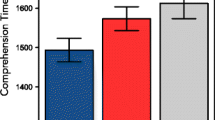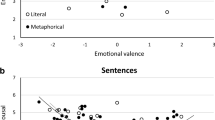Abstract
For 84 unique topic–vehicle pairs (e.g., knowledge–power), participants produced associated properties for the topics (e.g., knowledge), vehicles (e.g., power), metaphors (knowledge is power), and similes (knowledge is like power). For these properties, we also obtained frequency, saliency, and connotativeness scores (i.e., how much the properties deviated from the denotative or literal meaning). In addition, we examined whether expression type (metaphor vs. simile) impacted the interpretations produced. We found that metaphors activated more salient properties than did similes, but the connotativeness levels for metaphor and simile salient properties were similar. Also, the two types of expressions did not differ across a wide range of measures collected: aptness, conventionality, familiarity, and interpretive diversity scores. Combined with the property lists, these interpretation norms constitute a thorough collection of data about metaphors and similes, employing the same topic–vehicle words, which can be used in psycholinguistic and cognitive neuroscience studies to investigate how the two types of expressions are represented and processed. These norms should be especially useful for studies that examine the online processing and interpretation of metaphors and similes, as well as for studies examining how properties related to metaphors and similes affect the interpretations produced.
Similar content being viewed by others
Notes
We found only one study that has investigated the processing of copular metaphors employing expressions in the past tense (Cardillo, Watson, Schmidt, Kranjec, & Chatterjee, 2012); the reason might be the implications that verb tense might have for a categorization (Glucksberg, 2008) or a comparison statement (Gentner & Bowdle, 2008). For example, if someone says My lawyer was a shark, it implies that (a) the lawyer is no longer a shark, although he or she was for an extended period of time; (b) the lawyer was briefly in a given state (shark); or (c) there is no lawyer at the present moment. None of these possible implicatures involve categorizations or comparisons that endure, and thus arguably they weaken the potential impact of a figurative statement. By contrast, My lawyer is a shark conveys only that the lawyer is either a member of an (ad hoc) category or that a lawyer can be compared with sharks on some metric.
References
Amanzio, M., Geminiani, G., Leotta, D., & Cappa, S. (2008). Metaphor comprehension in Alzheimer’s Disease: Novelty matters. Brain and Language, 107, 1–10.
Asendorpf, J. B., Conner, M., De Fruyt, F., Houwer, J. D., Denissen, J. J. A., Fiedler, K., & Wicherts, J. M. (2013). Recommendations for increasing replicability in psychology. European Journal of Personality, 27, 108–119.
Balota, D. A., Yap, M. J., Cortese, M. J., Hutchison, K. A., Kessler, B., Loftis, B., & Treiman, R. (2007). The english lexicon project. Behavior Research Methods, 39, 445–459. doi:10.3758/BF03193014
Bambini, V., Gentili, C., Ricciardi, E., Bertinetto, P. M., & Pietrini, P. (2011). Decomposing metaphor processing at the cognitive and neural level through functional magnetic resonance imaging. Brain Research Bulletin, 86, 203–216. doi:10.1016/j.brainresbull.2011.07.015
Black, M. (1955). Metaphor. Proceedings of the Aristotelian Society, 55, 273–294.
Black, M. (1979). More about metaphor. In A. Ortony (Ed.), Metaphor and thought (pp. 19–43). Cambridge, UK: Cambridge University Press.
Blasko, D. G., & Briihl, D. S. (1997). Reading and recall of metaphorical sentences: Effects of familiarity and context. Metaphor and Symbol, 12, 261–285.
Blasko, D. G., & Connine, C. M. (1993). Effects of familiarity and aptness on metaphor processing. Journal of Experiment Psychology: Learning, Memory, and Cognition, 19, 295–308. doi:10.1037/0278-7393.19.2.295
Bowdle, B. F., & Gentner, D. (2005). The career of metaphor. Psychological Review, 112, 193–216. doi:10.1037/0033-295X.112.1.193
Campbell, J. D., & Katz, A. N. (2006). On reversing the topics and vehicles of metaphor. Metaphor and Symbol, 21, 1–22.
Cardillo, E. R., Schmidt, G. L., Kranjec, A., & Chatterjee, A. (2010). Stimulus design is an obstacle course: 560 matched literal and metaphorical sentences for testing neural hypotheses about metaphor. Behavior Research Methods, 42, 651–664. doi:10.3758/BRM.42.3.651
Cardillo, E. R., Watson, C. E., Schmidt, G. L., Kranjec, A., & Chatterjee, A. (2012). From novel to familiar: Tuning the brain for metaphors. NeuroImage, 59, 3212–3221.
Chettih, S., Durgin, F. H., & Grodner, D. (2012). Mixing metaphors in the cerebral hemispheres: What happens when careers collide? Journal of Experimental Psychology: Learning, Memory, and Cognition, 38, 295–311.
Chiappe, D. L., & Kennedy, J. M. (1999). Aptness predicts preference for metaphors or similes, as well as recall bias. Psychonomic Bulletin & Review, 6, 668–676.
Chiappe, D. L., & Kennedy, J. M. (2000). Are metaphors elliptical similes? Journal of Psycholinguistic Research, 29, 371–398.
Chiappe, D. L., & Kennedy, J. M. (2001). Literal bases for metaphor and simile. Metaphor and Symbol, 16, 249–276.
Chiappe, D. L., Kennedy, J. M., & Chiappe, P. (2003a). Aptness is more important than comprehensibility in preference for metaphors and similes. Poetics, 31, 51–68.
Chiappe, D. L., Kennedy, J. M., & Smykowski, T. (2003b). Reversibility, aptness, and the conventionality of metaphors and similes. Metaphor and Symbol, 18, 85–105.
Coltheart, M. (1981). The MRC psycholinguistic database. Quarterly Journal of Experimental Psychology, 33A, 497–505. doi:10.1080/14640748108400805
Coulson, S., & van Petten, C. (2002). Conceptual integration and metaphor: An event-related brain potential study. Memory & Cognition, 30, 958–968.
Danesi, M. (1998). Sign, thought, and culture. Toronto, ON, Canada: Canadian Scholars’ Press.
Davies, M. (2010). The corpus of contemporary American rnglish as the first reliable monitor corpus of english. Literary & Linguistic Computing, 25, 447–464. doi:10.1093/llc/fqq018
Gentner, D., & Bowdle, B. (2008). Metaphor as structure-mapping. In R. W. Gibbs Jr. (Ed.), The Cambridge handbook of metaphor and thought (pp. 109–128). New York, NY: Cambridge University Press.
Gentner, D., & Wolff, P. (1997). Alignment in the processing of metaphor. Journal of Memory and Language, 37, 331–355.
Gerrig, R. J., & Healy, A. F. (1983). Dual processes in metaphor understanding: Comprehension and appreciation. Journal of Experimental Psychology: Learning, Memory, and Cognition, 9, 667–675. doi:10.1037/0278-7393.9.4.667
Gibbs, R. W., Jr. (Ed.). (2008). The Cambridge handbook of metaphor and thought. Cambridge, UK: Cambridge University Press.
Giora, R. (1997). Understanding figurative and literal language: The graded salience hypothesis. Cognitive Linguistics, 7, 183–206.
Glucksberg, S. (2003). The psycholinguistics of metaphor. Trends in Cognitive Sciences, 7, 92–96.
Glucksberg, S. (2008). How metaphors create categories—quickly. In R. W. Gibbs Jr. (Ed.), The Cambridge handbook of metaphor and thought (pp. 109–128). New York, NY: Cambridge University Press.
Glucksberg, S., & Haught, C. (2006a). Can Florida become like the new Florida? When metaphoric comparisons fail. Psychological Science, 17, 935–938.
Glucksberg, S., & Haught, C. (2006b). On the relation between metaphor and simile: When comparison fails. Mind and Language, 21, 360–378.
Glucksberg, S., & Keysar, B. (1990). Understanding metaphorical comparisons: Beyond similarity. Psychological Review, 97, 3–18. doi:10.1037/0033-295X.97.1.3
Glucksberg, S., & Keysar, B. (1993). How metaphors work. In A. Ortony (Ed.), Metaphor and thought (2nd ed., pp. 401–424). Cambridge, UK: Cambridge University Press.
Glucksberg, S., & McGlone, M. S. (1999). When love is not a journey: What metaphors mean. Journal of Pragmatics, 31, 1541–1558.
Graesser, A. C. (1981). Prose comprehension beyond the word. New York, NY: Springer.
Harris, R. J., Friel, B. M., & Mickelson, N. R. (2006). Attribution of discourse goals for using concrete- and abstract-tenor metaphors and similes with or without discourse context. Journal of Pragmatics, 38, 863–879.
Hasson, U., Estes, Z., & Glucksberg, S. (2001). Metaphors communicate more effectively than do similes. Abstracts of the Psychonomic Society, 42nd Annual Meeting (p. 103). Austin, TX: Psychonomic Society.
Jones, L. L., & Estes, Z. (2005). Metaphor comprehension as attributive categorization. Journal of Memory and Language, 53, 110–124.
Jones, L. L., & Estes, Z. (2006). Roosters, robins, and alarm clocks: Aptness and conventionality in metaphor comprehension. Journal of Memory and Language, 55, 18–23.
Katz, A. N., Paivio, A., Marschark, M., & Clark, J. M. (1988). Norms for 204 literary and 260 nonliterary metaphors on 10 psychological dimensions. Metaphor and Symbolic Activity, 3, 191–214.
Kazmerski, V., Blasko, D., & Dessalegn, B. (2003). ERP and behavioral evidence of individual differences in metaphor comprehension. Memory & Cognition, 31, 673–689.
Lakoff, G. (1993). The contemporary theory of metaphor. In A. Ortony (Ed.), Metaphor and thought (2nd ed., pp. 202–251). Cambridge, UK: Cambridge University Press.
Lai, V. T., Curran, T., & Menn, L. (2009). Comprehending conventional and novel metaphors: An ERP study. Brain Research, 1284, 145–155.
McGlone, M. S., & Manfredi, D. (2001). Topic–vehicle interaction in metaphor comprehension. Memory & Cognition, 29, 1209–1219.
Miller, G. A. (1979). Images and models, similes and metaphors. In A. Ortony (Ed.), Metaphor and thought (pp. 202–250). New York, NY: Cambridge University Press.
Ortony, A. (1979). Beyond literal similarity. Psychological Review, 86, 161–180. doi:10.1037/0033-295X.86.3.161
Ortony, A. (1993). The role of similarity in similes and metaphors. In A. Ortony (Ed.), Metaphor and thought (2nd ed., pp. 342–356). New York, NY: Cambridge University Press.
Pierce, R. S., & Chiappe, D. L. (2008). The roles of aptness, conventionality, and working memory in the production of metaphors and similes. Journal of Metaphor and Symbol, 24, 1–19.
Prat, C. S., Mason, R. A., & Just, M. A. (2012). An fMRI investigation of analogical mapping in metaphor comprehension: The influence of context and individual cognitive capacities on processing demands. Journal of Experimental Psychology: Learning, Memory, and Cognition, 38, 282–294.
Pynte, J., Besson, M., Robichon, F., & Poli, J. (1996). The time-course of metaphor comprehension: An event-related potential study. Brain and Language, 55, 293–316.
Richards, I. A. (1936). The philosophy of rhetoric. Oxford, UK: Oxford University Press.
Roberts, R. M., & Kreuz, R. J. (1994). Why do people use figurative language? Psychological Science, 5, 159–163.
Roncero, C., & de Almeida, R. G. (2014, July). Alike or different: Comparing the online processing of metaphors and similes. Paper to be presented at the 24th Annual Meeting of the Canadian Society for Brain, Behaviour, and Cognitive Science (CSBBCS), Toronto, ON, Canada
Roncero, C., Kennedy, J. M., & Smyth, R. (2006). Similes on the Internet have explanations. Psychonomic Bulletin & Review, 13, 74–77. doi:10.3758/BF03193815
Shannon, C. (1948). A mathematical theory of communication. Bell System Technical Journal, 27, 379–423.
Shibata, M., Toyomura, A., Motoyama, H., Itoh, H., Kawabata, Y., & Abe, J. (2012). Does simile comprehension differ from metaphor comprehension? A functional MRI study. Brain and Language, 121, 254–260.
Tartter, V. C., Gomes, H., Dubrovsky, B., Molholm, S., & Stewart, R. V. (2002). Novel metaphors appear anomalous at least momentarily: Evidence from N400. Brain and Language, 80, 488–509.
Thibodeau, P. H., & Durgin, F. H. (2011). Metaphor aptness and conventionality: A processing fluency account. Metaphor and Symbol, 26, 206–226.
Tversky, A. (1977). Features of similarity. Psychological Review, 84, 327–352. doi:10.1037/0033-295X.84.4.327
Utsumi, A. (2005). The role of feature emergence in metaphor appreciation. Metaphor and Symbol, 20, 151–172.
Utsumi, A. (2007). Interpretive diversity explains metaphor-simile distinction. Metaphor and Symbol, 22, 291–312.
Xu, X. (2010). The relationship between content and the form of metaphorical statements. Journal of Psycholinguistic Research, 39, 165–178.
Author note
This study was supported by graduate fellowships from the Social Sciences and Humanities Research Council of Canada (SSHRC) and by the Alzheimer’s Society of Canada to C.R., and by a grant from SSHRC to R.G.d.A. We thank Effie Andreadakis for organizing and tabulating the associated property lists, and are grateful to Gregory Francis and two anonymous reviewers for suggestions on an earlier version of this article.
Author information
Authors and Affiliations
Corresponding author
Rights and permissions
About this article
Cite this article
Roncero, C., de Almeida, R.G. Semantic properties, aptness, familiarity, conventionality, and interpretive diversity scores for 84 metaphors and similes. Behav Res 47, 800–812 (2015). https://doi.org/10.3758/s13428-014-0502-y
Published:
Issue Date:
DOI: https://doi.org/10.3758/s13428-014-0502-y




